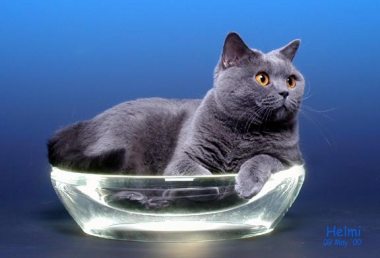Dilution refers to making a colour lighter as if mixing it with white. When black is made lighter is becomes a pale or slate grey. Sarah Hartwell refers to it as ‘blue dilution’. Grey is not blue but there is a slight bluish tinge to the grey cat coat. The cat fancy prefers to use ‘blue’ rather than ‘grey’ (US: gray). This may partly be because blue sounds more interesting than drab grey. There may be a marketing element in deciding to adopt this slightly strange description. It can confuse people outside the cat fancy.

The location, size, shape and density of the melanin pigment granules in the hair shafts dictates the colour of the coat. The images by Sarah of the normal distribution and size of melanin granules in a black cat are compared with that of the grey cat. It shows the larger pigment granules unevenly distributed.

Blue dilution was (still is?) referred to as ‘the Maltese dilution’ because grey cats were prevalent on the island of Malta. It is ‘an autosomal recessive trait of cats that dilutes black cats to blue, and orange cats to cream’ (Prieur DJ, Collier LL. Maltese dilution of domestic cats. A generalized cutaneous albinism lacking ocular involvement. J Hered. 1984 Jan-Feb;75(1):41-4). ‘Autosomal’ means a gene that is not sex-linked.
‘Blue-cream’ is the dilute form of the tortoiseshell pattern. The blue replaces the black and the cream replaces the red. You get a dilute (faint) tortoiseshell coat. You see the same on dilute calico cats (tortoiseshell and white).


It seems that the dilution gene also affects wild cats. In 1938, the skin of a Canadian lynx from Alaska donated to the US National Museum had a bluish-grey colour rather than the usual fawn. Fur traders said that these mutations occurred 1-2 every 1000 coats.

Mysterious blue tigers (Maltese tiger) have been recorded. They had slate grey or black stripes on a pale grey background. Sarah Hartwell suggests that the blue tiger was due to a colour mutation producing a grey-blue pigment rather than the orange. Dr Desmond Morris says that there is no scientific evidence to support the existence of blue tigers.
In the cat fancy there are many pattern variants of blue dilution including, for example, the blue chinchilla silver, blue cream smoke, blue, cream and white (dilute tricolour), blue silver tabby and so on. The Russian Blue has blue in its name. This is a grey cat. Watch out for photo-edited pictures of the Russian Blue or the blue British Shorthair to make them look bluer! Look at the example below! It has a horrible cyan/blue colour bias.

SOME MORE ON GENETICS:

